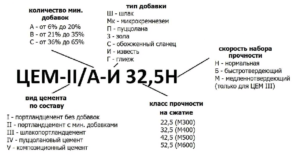
In the construction industry, cement is one of the materials in high demand. Therefore, manufacturers are constantly increasing the volume of its production. Such positive dynamics is often used by unscrupulous manufacturers, whose low-quality products can be found on the building materials market.
They, as a rule, add special additives to the cement, which significantly affect the quality of the cement mixture.
To avoid mistakes when buying cement, you should know:
- How to distinguish real high-quality cement from a fake
- What are the properties and features of cement
Cement is sold in loose form and in bags. As a rule, the best purchase option is to buy it in bags, as in such a package it will be better protected from external factors. Also, it will be able to maintain its qualities much longer.
And on top of that, on the packaging there is all the necessary information about its composition, date of manufacture, main characteristics and everything about the manufacturer. Bags for cement are made of paper with two layers, where the inner one serves to protect the cement from getting wet. It should be noted that in the absence of any information on the packaging, this indicates that such cement is most likely of poor quality.
When buying bulk cement in bags, be sure to check each bag for information on the expiration date. This is due to the fact that with a large quantity, they can also sell goods that have already been stale in the total mass. It is also important to know that after 6 months from the moment of production, the activity of cement sharply loses its properties several times.
The freshness of cement can also be checked experimentally for a long time. To do this, it is worth hitting the bag with your foot or hand. Your sensations should not remind you that you hit a stone. The cement starts to harden at the corners of the bag, which is the first thing to check. And, of course, if there is no date of manufacture on the package, then it is best to refuse such a product.
Cement must be stored in a room that is well ventilated, as in other conditions it will quickly harden.
High-quality cement has its own true color - it is gray, and to be more precise, it can also be light gray and dark gray, and maybe even with a greenish tint. Marsh and dark shades are not allowed. Also, high-quality cement immediately crumbles in the hand and does not crumple into a lump when compressed.
The hardening process is influenced by the fineness of grinding. A smaller fraction of particles will ensure rapid hardening of the composition and therefore the cost of such cement will be higher. If the fraction is too small, then water consumption increases significantly and therefore, when buying cement, fractions with a size of 40 to 80 microns will be an ideal option.
When buying cement, it will not be superfluous to evaluate its composition and characteristics. This procedure is not difficult in itself. You just need to prepare bicarbonate-sodium water in advance (Borjomi may also be suitable).
Before using such water for kneading cement paste, gas must be released from it. And after that, form cakes with a diameter of 15 cm. In the center, such a cake should be thicker - within 5 cm and 1 cm along the edges. If the cement is of high quality, then no later than 10 minutes it should begin to set, and the part that is thicker will begin to heat up . But if even within 30 minutes no setting occurs, then this indicates that such a composition is of low quality.